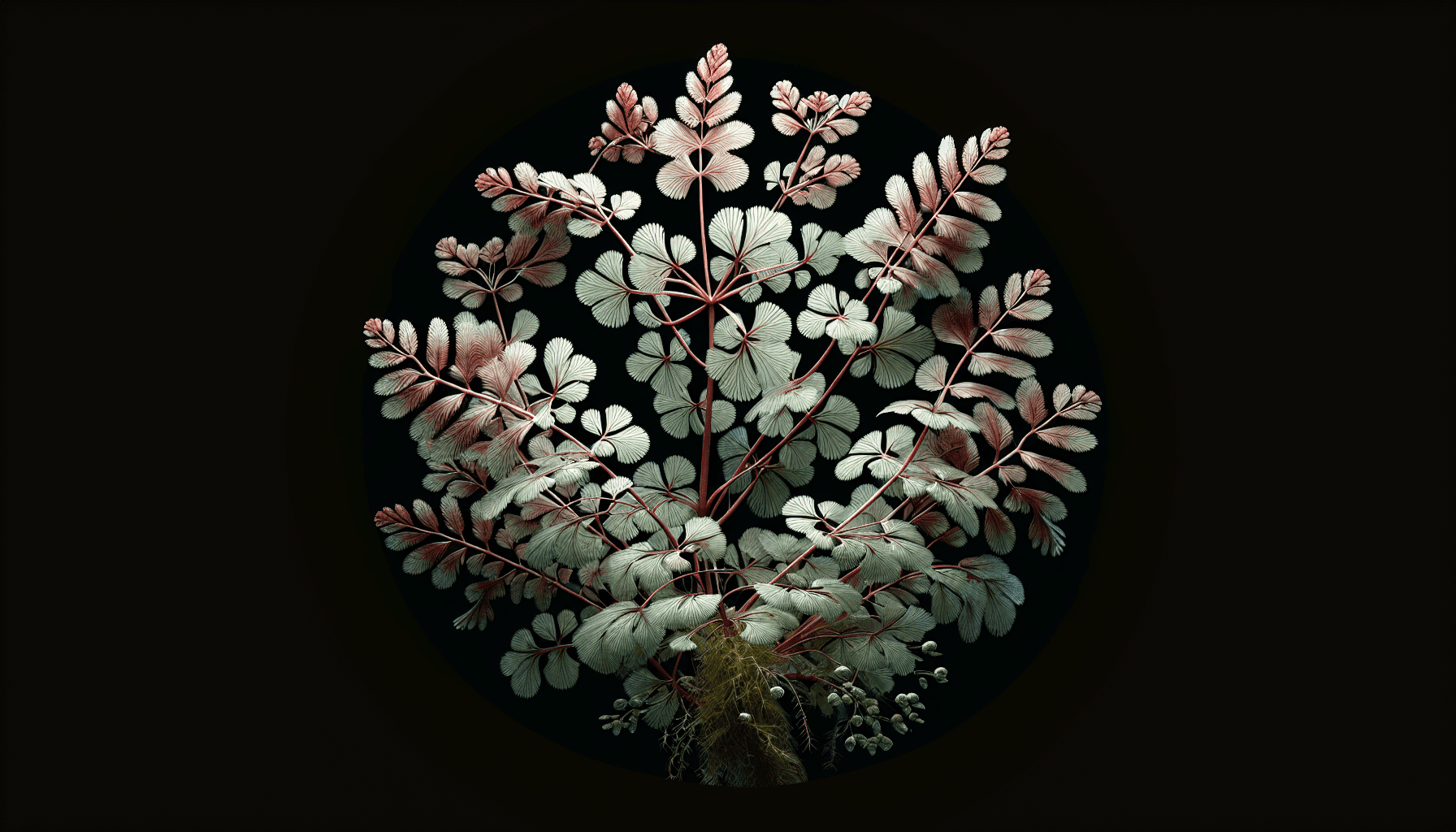As an inquisitive mind seeking to deepen your understanding of aquatic botany, it’s crucial to familiarize yourself with the species that inhabit these fascinating ecosystems. Among these is the aquatic weed Myriophyllum verticillatum, a prevalent subject of research owing to its interesting characteristics. This article aims to elucidate the principal features of Myriophyllum verticillatum– its biological origins, adaptive abilities, and propagation mechanisms – as well as the broader context within aquatics, such as its potential proliferation hazards and ecological impact. In doing so, you’ll gain an enriched understanding of this aquatic weed’s intriguing nature.

Basic Information about Myriophyllum Verticillatum
Myriophyllum Verticillatum, a species of aquatic plant, is a significant part of various ecosystems around the world. The plant species is known for its numerous characteristics that influence both the environment and the species living within it.
Scientific classification
Classified under the kingdom of Plantae, Myriophyllum Verticillatum belongs to the angiosperms, the eudicots, the rosids, and the haloragaceae family. Its genius name “Myriophyllum” means myriad leaves, referring to its multifarious foliation. The species name “Verticillatum,” derived from Latin, refers to the whorled nature of its leaves.
Origins and distribution
Native to much of the northern hemisphere, Myriophyllum Verticillatum can be found sprouting in various types of freshwater habitats. From the continent of North America to Europe and as far as Asia, these aquatic plants can adapt to different types of environments.
Common names
Known by various common names around the world, Myriophyllum Verticillatum is popularly referred to as Eurasian watermilfoil, whorled watermilfoil, spiked watermilfoil, or simply the aquatic weed.
Physical Features
The distinguishing physical features of Myriophyllum Verticillatum contribute significantly to its ecological role and invasive potential.
Stem and Branches
With stems that can grow up to six meters in length, Myriophyllum Verticillatum is a robust aquatic plant. Because of its long stems that bear branches, this plant species often forms dense canopies at the water surfaces of streams, ponds, and lakes, affecting aquatic light availability and water movement.
Leaves
The leaves of the Myriophyllum Verticillatum give it a unique identity. Characterized by a whorled pattern and fine, dissected segments, the leaves of this plant give it a feathery appearance.
Flowers and Seeds
Small, inconspicuous flowers emerge from the leaf axils, often protruding above the water surface. These flowers are usually reddish-pink or greenish in color and give rise to seeds that are about 1-2 mm in size. The reproductive potential of these seeds, however, is relatively low, and it primarily reproduces vegetatively.
Habitat and Distribution
The versatile nature of Myriophyllum Verticillatum allows it to thrive in various environmental conditions.
Preferred environmental conditions
Myriophyllum Verticillatum is remarkably adaptive and, as such, can survive a broad range of temperatures, making it a common sight in both warm and cool waters. It prefers nutrient-rich, light conditions and can grow in a variety of substrates – from silty to rocky bottom sediments.
Geographical spread
This aquatic plant species is known to inhabit freshwater bodies worldwide. However, it is primarily native to areas in North America, Europe, and parts of Asia.

Life-cycle of Myriophyllum Verticillatum
The life-cycle of Myriophyllum Verticillatum is an integral part of its ability to modify the aquatic ecosystems in which it resides.
Growth stages
From seed germination to adult, the Myriophyllum Verticillatum goes through various stages of growth – each stage characterized by different physiological and morphological changes. It can grow from fragments or seeds, with new plants branching off from the nodes of parent plants.
Seasonal changes
Its growth is incredibly nuanced and is influenced significantly by seasonal changes. For instance, during the onset of spring, it starts growing rapidly, forming dense mats by summer which then decay by fall, releasing nutrients back into the water.
Reproductive cycle
The primary mode of reproduction in Myriophyllum Verticillatum is vegetative, where new plantlets develop from fragments. However, in the presence of favorable conditions, it may also reproduce sexually via the production of seeds.
Significance to the Ecosystem
The ecological significance of Myriophyllum Verticillatum cannot be understated, as it plays vital roles in the functioning of aquatic ecosystems.
Role in aquatic environments
In the aquatic environments, Myriophyllum Verticillatum provides habitation and breeding grounds for many species of invertebrates and fish. By altering the light and nutrient levels, it can impact primary production and therefore, the food web dynamics.
Interactions with fish and aquatic creatures
Myriophyllum Verticillatum provides habitat to a wide variety of fauna, such as small fish and invertebrates, offering them refuge and breeding grounds. However, it may also impede the free movement of larger fish species in the water bodies.
Impact on water quality
Through the decomposition of its dead organic matter, Myriophyllum Verticillatum influences the oxygen, pH, and nutrient dynamics of the waters, notably reducing water quality.
Culinary and Medicinal Uses
Though mostly considered as a nuisance weed, the Myriophyllum Verticillatum does have some potential usage in both culinary and medicinal fields.
Traditional uses as food source
While not as common, some cultures reportedly use the plant parts as a food source, often in the form of soups and broths.
Potential medicinal properties
There is continuing research on the potential medicinal properties of Myriophyllum Verticillatum, with studies pointing to the plant exhibiting indications of antimicrobial activity.
Impact as an Invasive Species
Due to its robust growth, Myriophyllum Verticillatum poses significant threats to native biodiversity, economy, and recreational water-use activities.
Threats to native biodiversity
The rapid and dense formation of mats of the Myriophyllum Verticillatum can outcompete native plant species for resources and sunlight, resulting in changes in the biodiversity and structure of the plant communities in the water bodies.
Economic impact
The growth of Myriophyllum Verticillatum can obstruct boating, fishing, and other recreational activities, causing economic losses.
Methods of control and management
To manage the invasive potential of Myriophyllum Verticillatum, several control methods such as mechanical harvesting, the use of herbicides, and even the introduction of herbivore species like milfoil weevils are employed based on the specific scenarios.
Research and Studies on Myriophyllum Verticillatum
Scientific research into the nature and effects of Myriophyllum Verticillatum is ongoing, revealing novel insights about its biology, ecology and potential uses.
Latest scientific findings
Recent studies have extended our understanding of Myriophyllum Verticillatum’s adaptive capabilities, tolerance ranges, and effects on the receiving environment; such knowledge is vital to inform more effective control strategies and public education efforts.
Ongoing research
Many ongoing research projects are committed to further illuminating the responses of Myriophyllum Verticillatum to various environmental factors, its biodiversity effects, potential uses, and invasion management.
Myriophyllum Verticillatum in Aquascaping
Despite its notorious reputation, Myriophyllum Verticillatum occupies a special place in aquarium compositions due to its unique aesthetic appeal.
Utilization in aquariums
The feathery, delicate looking leaves of Myriophyllum Verticillatum, coupled with its versatility, make it a popular choice among aquarists. It is particularly used to provide cover for smaller fish species and invertebrates in the aquariums.
Care and maintenance tips
While Myriophyllum Verticillatum can adapt to a range of conditions, it thrives best in well-lit aquatic environments and amply fertilized substrates.
Propagating in a controlled environment
Propagation is easily achievable simply by cutting the stems and replanting them in the substrate. Even though it is a hardy species, caution should be observed in its cultivation to prevent unintended introductions into natural water bodies.
Protection and Conservation
Uncontrolled overgrowth of Myriophyllum Verticillatum necessitates comprehensive conservation strategies.
Threats and challenges
As with any invasive species, Myriophyllum Verticillatum confronts us with the challenge of preserving biodiversity, maintaining ecosystem functionality, and supporting human use of aquatic resources.
Conservation efforts
Strategy development for the control of Myriophyllum Verticillatum involves a multi-faceted approach – combining biological, mechanical, and chemical methods, and regular monitoring of invaded water bodies.
Role of community in conservation
Community awareness and active participation is a crucial component of ecosystem conservation. The prompt reporting of the presence of Myriophyllum Verticillatum and conscientious practices in recreational water activities can avert, or at least, manage, its unwanted spread.